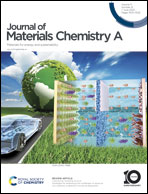An effective integrated Cu2O photocathode to boost photoelectrocatalytic CO2 conversion†
Abstract
The exploitation of high-performance photocathodes remains a key challenge to bring the feasibility of narrow bandgap semiconductors into fruition for efficient artificial photosynthesis. Herein, we show a highly efficient photocathode system consisting of a photonic crystal structure based on a cuprous oxide (Cu2O) semiconductor for good light harvesting, hole-transport layers (HTL: FeOOH) that mediate and stipulate interfacial charge transfer derection from Cu2O to FTO, and a polypyrrole (PPy) layer as a sequential multi-electron transfer agent for CO2 reduction. The integrated Cu2O photocathode exhibits a record CO yield of up to 46.17 μmol h−1 at −2.0 V vs. Ag/Ag+, which achieves a high half-cell solar to CO efficiency (ηSTC) of 1.58% and delivers an optimal quantum efficiency of 3.08%, transcending most of the previous Cu2O based photocathodes. Moreover, the integrated photocathode systems exhibit 7 hours operational stability. This work could shed light on designing and constructing efficient photocathode architecture for enabling practical solar-driven CO2 reduction as a means of solar energy storage.

- This article is part of the themed collection: #MyFirstJMCA


 Please wait while we load your content...
Please wait while we load your content...